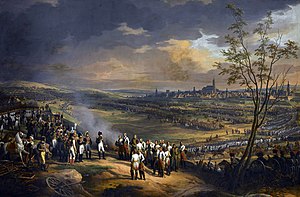Ulm Campaign
| Ulm Campaign | |||||||
|---|---|---|---|---|---|---|---|
| Part of the War of the Third Coalition | |||||||
 The Capitulation of Ulm by Charles Thévenin, where General Mack and 23,000 Austrian troops surrendered to Napoleon. |
|||||||
|
|||||||
| Belligerents | |||||||
|
|
|
||||||
| Commanders and leaders | |||||||
| Strength | |||||||
| 235,000 (including 25,000 Bavarians) | 72,000 | ||||||
| Casualties and losses | |||||||
| 2,000 | 60,000 (mostly surrendered) | ||||||
The Ulm Campaign consisted of a series of French and Bavarian military maneuvers and battles to outflank and capture an Austrian army in 1805 during the War of the Third Coalition. It took place in the vicinity of and inside the Swabian (then Bavarian) city of Ulm. The French Grande Armée, led by Napoleon Bonaparte, comprised 210,000 troops organized into seven corps, and hoped to knock out the Austrian army in the Danube before Russian reinforcements could arrive. Through rapid marching, Napoleon conducted a large wheeling maneuver that captured an Austrian army of 23,000 under General Mack on 20 October at Ulm, bringing the total number of Austrian prisoners in the campaign to 60,000. The campaign is generally regarded as a strategic masterpiece and was influential in the development of the Schlieffen Plan in the late 19th century.
...
Wikipedia
